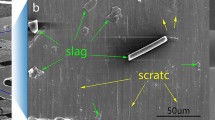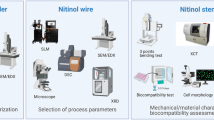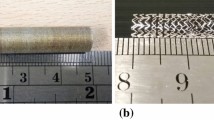Abstract
Selective laser melting (SLM) has gained great attention to manufacture cardiovascular stents given its potential of fabricating customized stents with complex shapes to satisfy clinical requirements. In this study, the surface characteristics of NiTi cardiovascular stents by SLM were explored. The effect of SLM machining parameters on surface morphology, geometry accuracy, phase composition, surface roughness, and contact angle were analyzed. The results demonstrated that the surface morphology of stent became more irregular, and the surface roughness was enhanced accompanied by the volume energy density (VED) increased. SLMed stents exhibited hydrophobic properties, and the rougher surface obtained a lower contact angle. The deviation of strut thickness was more than 200% than the nominal value under 194 J/mm3. The lowest VED displayed a strong cubic B2 structure with less content loss of Ni, satisfying the self-expand NiTi stent requirements. Then electrochemical polishing (ECP) process with green electrolytes distinctly improved the surface quality, providing smoother surfaces. The surface roughness reduced minimum to 0.45 μm from 6.64 μm for SLMed stent, and the average strut thickness was reduced to 230 μm at most. Finally, electrochemical test results revealed that SLM-ECPed stents showed a more obvious tendency to resist corrosion compared to SLMed stents.














Similar content being viewed by others
References
Sullivan S, Madamba D, Sivan S (2017) The effects of surface processing on in-vivo corrosion of nitinol stents in a porcine model. Acta Biomater 62:385–396. https://doi.org/10.1016/j.actbio.2017.08.029
Yang X, Yang Q, Shi YS, Yang L, Wu SQ, Yan CZ, Shi YS (2022) Effect of volume fraction and unit cell size on manufacturability and compressive behaviors of Ni-Ti triply periodic minimal surface lattices. Addit Manuf 54:102737. https://doi.org/10.1016/j.addma.2022.102737
Sreesha RB, Ladakhan SH, Mudakavi D, Adinarayanappa SM (2022) An experimental investigation on performance of NiTi-based shape memory alloy 4D printed actuators for bending application. Int J Adv Manuf Technol 122:4421–4436. https://doi.org/10.1007/s00170-022-09875-w
Biffi CA, Fiocchi J, Tuissi A (2022) Relevant aspects of laser cutting of niti shape memory alloys. J Mater Res Technol 19:472–506. https://doi.org/10.1016/j.jmrt.2022.03.146
Kim JH, Kang TJ, Yu WR (2008) Mechanical modeling of self-expandable stent fabricated using braiding technology. J Biome 41(15):3202–3212. https://doi.org/10.1016/j.jbiomech.2008.08.005
Singh C, Wang XG (2016) A biomechanically optimized knitted stent using a bio-inspired design approach. Text Res J 86(4):380–392. https://doi.org/10.1177/0040517515590413
Harun W, Kamariah M, Muhamad N, Ghani S, Ahmad F, Mohamed Z (2018) A review of powder additive manufacturing processes for metallic biomaterials. Powder Technol 327:128–151. https://doi.org/10.1016/j.powtec.2017.12.058
Khalaj R, Tabriz AG, Okereke MI, Douroumis D (2021) 3D printing advances in the development of stents. Inter J Pharm 609:121153. https://doi.org/10.1016/j.ijpharm.2021.121153
Li Y, Shi Y, Lu Y, Li X, Zhou J, Zadpoor A, Wang L (2023) Additive manufacturing of vascular stents. Acta Biomater 167:16–37. https://doi.org/10.1016/j.actbio.2023.06.014
Korei N, Solouk A, Nazarpak MH, Nouri A (2022) A review on design characteristics and fabrication methods of metallic cardiovascular stents. Mater Today Commun 31:103467. https://doi.org/10.1016/j.mtcomm.2022.103467
Demir AG, Previtali B (2017) Additive manufacturing of cardiovascular CoCr stents by selective laser melting. Mater Des 119:338–350. https://doi.org/10.1016/j.matdes.2017.01.091
Finazzi V, Demir AG, Biffi CA, Migliavacca F, Paterini L, Previtali B (2020) Design and functional testing of a novel balloon-expandable cardiovascular stent in CoCr alloy produced by selective laser melting. J Manuf Processes 55:161–173. https://doi.org/10.1016/j.jmapro.2020.03.060
Wen P, Voshage M, Jauer L, Chen YZ, Qin Y, Poprawe R, Schleifenbaum JH (2018) Laser additive manufacturing of Zn metal parts for biodegradable applications: processing, formation quality and mechanical properties. Mater Des 155:36–45. https://doi.org/10.1016/j.matdes.2018.05.057
Finazzi V, Berti F, Guillory II, Petrini L, Previtali B, Demir AG (2022) Patient-specific cardiovascular superelastic NiTi stents produced by laser powder bed fusion. Procedia CIRP 10:242–246. https://doi.org/10.1016/j.procir.2022.06.044
Zhao CY, Liang HL, Luo SC, Yang JJ, Wang ZM (2020) The effect of energy input on reaction, phase transition and shape memory effect of NiTi alloy by selective laser melting. J Alloys Compd 817:153288. https://doi.org/10.1016/j.jallcom.2019.153288
Shim JW, Bae IH, Park DS (2017) Evaluation of ion implantation for anti-thrombogenic coronary stent in vitro and in vivo. J Ind Eng Chem 54:290–297. https://doi.org/10.1016/j.jiec.2017.06.003
Istanbullu OB, Akdogan G (2023) Increased body fluid repellency and electrochemical corrosion resistance of intravascular stent materials by ICP-CVD-based DLC thin-film deposition. Diamond Relat Mater 138:110251. https://doi.org/10.1016/j.diamond.2023.110251
Safdel A, Elbestawi MA (2021) Distortion and printability of stent structures in laser powder bed fusion processing of NiTi alloys. Mater Lett 300:130163. https://doi.org/10.1016/j.matlet.2021.130163
Narayanan C, Anand P (2023) Selective laser melting and post-processing stages for enhancing the material behavior of cobalt-chromium alloy in total hip replacement: a review. Mater Manuf Processes 38(5):495–515. https://doi.org/10.1080/10426914.2022.2105879
Finazzi V, Berti F, Petrini L, Previtali B, Demir AG (2023) Additive manufacturing and post-processing of superelastic NiTi micro struts as building blocks for cardiovascular stents. Addit Manuf 70:103561. https://doi.org/10.1016/j.addma.2023.103561
Li X, Hao SJ, Du BP, Feng B, Li HH, Qiu P, Huang BM, Cui LS, Yang Y (2022) High-performance self-expanding NiTi stents manufactured by laser powder bed fusion. Met Mater Int 29(5):1510–1521. https://doi.org/10.1007/s12540-022-01317-2
Mu JR, Sun TT, Leung C, Oliveira JP, Wu Y, Wang HW, Wang HZ (2023) Application of electrochemical polishing in surface treatment of additively manufactured structures: a review. Prog Mater Sci 136:101109. https://doi.org/10.1016/j.pmatsci.2023.101109
Maffia S, Finazzi V, Berti F, Migliavacca L, Petrini L, Previtali B, Demir AG (2021) Selective laser melting of NiTi stents with open-cell and variable diameter. Smart Mater Struct 30(10):105010. https://doi.org/10.1088/1361-665X/ac1908
Yung KC, Zhang SS, Duan L, Choy HS, Cai ZX (2019) Laser polishing of additive manufactured tool steel components using pulsed or continuous-wave lasers. Int J Adv Manuf Technol 105:425–440
Wang YQ, Wei XT, Li ZY, Jing XM, Gong ZK (2022) Effect of an environmentally friendly electrolyte on the biocompatibility of nickel–titanium alloy cardiovascular stents. J Appl Electrochem 52:1409–1418. https://doi.org/10.1007/s10800-022-01711-z
Han QQ, Gu H, Soe S, Setchi R, Lacan F, Hill J (2018) Manufacturability of AlSi10Mg overhang structures fabricated by laser powder bed fusion. Mater Des 160:1080–1095. https://doi.org/10.1016/j.matdes.2018.10.043
Sing SL, Wiria FE, Yeong WY (2018) Selective laser melting of lattice structures: a statistical approach to manufacturability and mechanical behavior. Robot Comput Integr Manuf 48:170–180. https://doi.org/10.1016/j.rcim.2017.06.006
Zahedmanesh H, Lally C (2009) Determination of the influence of stent strut thickness using the finite element method: implications for vascular injury and in-stent restenosis. Med Bio Eng Comput 47(4):385–393. https://doi.org/10.1007/s11517-009-0432-5
Shim JW, Bae IH, Park DS, Lim KS, Lee SY, Jang EJ, Park JK, Kim JH, Jeong MH (2017) Evaluation of ion implantation for anti-thrombogenic coronary stent in vitro and in vivo. Ind Eng Chem 54:290–297. https://doi.org/10.1016/j.jiec.2017.06.003
Kityk A, Protsenko V, Danilov F, Pavlik V, Hnatko M, Soltýs J (2021) Enhancement of the surface characteristics of Ti-based biomedical alloy by electropolishing in environmentally friendly deep eutectic solvent (Ethaline). Colloids Surf A 613:126125. https://doi.org/10.1016/j.colsurfa.2020.126125
Mukherjee T, Zuback JS, De A, DebRoy T (2016) Printability of alloys for additive manufacturing. Sci Rep 6:19717. https://doi.org/10.1038/srep19717
Jamshidi P, Panwisawas C, Langi E, Cox SC, Feng JL, Zhao LG, Attallah MM (2022) Development, characterisation, and modelling of processability of nitinol stents using laser powder bed fusion. J Alloys Compd 909:164681. https://doi.org/10.1016/j.jallcom.2022.164681
Qiu P, Gao PP, Wang SY, Li ZH, Yang Y, Zhang QQ, Xiong ZW, Hao SJ (2020) Study on corrosion behavior of the selective laser melted NiTi alloy with superior tensile property and shape memory effect. Corros Sci 175(11):108891. https://doi.org/10.1016/j.corsci.2020.108891
Yu ZL, Xu ZZ, Guo YT, Sha PW, Liu RY, Xin RL (2022) Analysis of microstructure, mechanical properties, wear characteristics and corrosion behavior of SLM-NiTi under different process parameters. J manuf processes 75:637–650. https://doi.org/10.1016/j.jmapro.2022.01.010
Hosseini SA, Karimidoost M, Emamian M (2023) Electrochemical dealloying of porous NiTi alloy: porosity evolution, corrosion resistance, and biocompatibility behavior. Intermetallics 152:107756. https://doi.org/10.1016/j.intermet.2022.107756
Funding
This work was supported by the Natural Science Foundation of Shandong Province under Grant (ZR2020ME161).
Author information
Authors and Affiliations
Contributions
WZ: experiments, writing the original draft, result analysis. ZL: resources, editing, data curation, project administration. CX: methodology, investigation, experiments. MC: resources, supervision. PD: conceptualization, resources.
Corresponding author
Ethics declarations
Ethical approval
This work has not been published elsewhere.
Competing interests
The authors declare no competing interests.
Additional information
Publisher’s Note
Springer Nature remains neutral with regard to jurisdictional claims in published maps and institutional affiliations.
Rights and permissions
Springer Nature or its licensor (e.g. a society or other partner) holds exclusive rights to this article under a publishing agreement with the author(s) or other rightsholder(s); author self-archiving of the accepted manuscript version of this article is solely governed by the terms of such publishing agreement and applicable law.
About this article
Cite this article
Zhang, W., Li, Z., Xu, C. et al. Surface characteristics of NiTi cardiovascular stents by selective laser melting and electrochemical polishing. Int J Adv Manuf Technol 130, 623–634 (2024). https://doi.org/10.1007/s00170-023-12734-x
Received:
Accepted:
Published:
Issue Date:
DOI: https://doi.org/10.1007/s00170-023-12734-x




